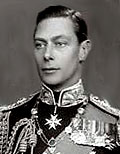Albert Frederick Arthur George was the second son of the Prince of Wales (later King George V). Like his father, who was also the second son of a reigning sovereign, Albert was not prepared for the role of monarch. During World War I, he served in the Royal Navy and the Royal Naval Air Service. After the war Albert entered Trinity College, Cambridge, where he studied from 1919-1920. Created the Duke of York in 1920, he became heir presumptive upon the accession of his older brother, Edward VIII, in 1936. The Abdication Crisis led to Edward's renunciation of the British throne and the Duke of York succeeded him as George VI being formally proclaimed on 12 Dec 1936. In 1937 George VI began a series of state goodwill visits, traveling to France in 1937 and to Canada and the United States in 1939. After the years of "appeasement" policy pursued by the governments of Stanley Baldwin and Neville Chamberlain, Britain declared war on Germany on 3 Sep 1939. Although he intended to ask Edward Halifax to form a government after the resignation of Chamberlain, George followed the advice of political leaders and appointed Winston Churchill, with whom he closely cooperated throughout the war. Following his father's example, George supported the war effort by visiting troops, munitions factories, supply docks and bomb-damaged areas. The reign of George VI witnessed the further change in the role of British monarchy becoming an institute of political representation. After World War II, George presided over the transformation of the British Empire into the Commonwealth of Nations. India and Pakistan received independence in 1947 followed by Burma and Ceylon in 1948. George ceased to be the Emperor of India and he was formally recognized (27 Apr 1949) as head of the Commonwealth by the governments of its member states. Since 1948 the king suffered from serious illness, which prevented him from active participation in the public life in his later years. |

